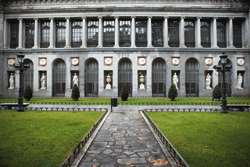
Cultural Heritage in the Digital World
By Jaime de Mendoza Fernández
The key points discussed at a conference in Madrid, co-organized by WIPO and the Spanish government, are highlighted here for the WIPO Magazine by Jaime de Mendoza Fernández, Head of Section, Copyright Unit, Ministry of Culture, Spain.
Peoples in every country of the world have rich cultural heritages that deserve to be discovered, enjoyed and learned from; in short, to be disseminated for public benefit. But at the same time, that culture needs to be conserved for future generations. The WIPO conference on Intellectual Property and Cultural Heritage in the Digital World, organized jointly with the Ministry of Culture of Spain, focused on striking a balance between intellectual property (IP) rights and the public’s right to have access to culture.
Participants in the conference included representatives of various cultural institutions – archives, libraries, museums and the like. Once seen as sacred coffers guarding the treasures of the world’s cultural heritage and granting access only to a select few, cultural institutions have now become the movers and shakers of culture and have shifted to an open-door policy. At the conference, these institutions offered their unique perspective as custodians, or repositories, of cultural heritage with the obligation and responsibility to preserve and protect the legacy entrusted to them and make it available to the public.
A paradigm shift

Prado National Museum in Madrid (Istockphoto.com)
Representatives of various cultural bodies highlighted the challenges and opportunities presented by the new policy for disseminating culture in the digital world. Without a doubt, one of the most crucial challenges is to find a way to balance the dissemination of collections with the need to protect IP rights.
Representatives of Spain’s largest cultural institutions, such as the Prado National Museum and the National Library, agreed with their European and North and Latin American counterparts that IP rights are increasingly important assets, both from a cultural as well as an economic viewpoint. Generating revenue from the added-value of IP rights has traditionally been seen in continental Europe as incompatible with the principal functions of public cultural institutions; today, however, it is seen in a more positive light. IP offers cultural institutions a means to generate significant revenue, allowing them to move towards becoming self-financing.
Managing IP rights
Cultural institutions are generous in making available the collections in their care. But in order to continue their efforts in the conservation, research and dissemination of cultural heritage, they are calling for a relaxing of current IP restrictions. The main difficulty they face is in managing the IP rights that apply to their collections. Specifically, the absence of a “one-stop shop” for communicating with rights management bodies, the lack of clarity surrounding the public domain and difficulties in managing so-called orphan works (i.e., works whose right holders are unknown or unreachable), were some of the most hotly debated issues during the conference.
The alternatives offered by the existing legal framework in relation to orphan works, for example, do not meet the needs of cultural institutions. They are, therefore, requesting a broadening of the current rules to allow them to use such works in certain instances, such as for the benefit of the disabled or for educational purposes.
To better address those challenges, participants agreed it was essential to create a constructive dialogue among cultural institutions, representatives of content industries, right holders and providers of information technology services. Both WIPO and the Ministry of Culture of Spain can play a fundamental role in fostering a climate of greater legal certainty for all stakeholders by promoting normative harmonization at the international level.
________________________________
The WIPO Magazine is intended to help broaden public understanding of intellectual property and of WIPO’s work, and is not an official document of WIPO. The designations employed and the presentation of material throughout this publication do not imply the expression of any opinion whatsoever on the part of WIPO concerning the legal status of any country, territory or area or of its authorities, or concerning the delimitation of its frontiers or boundaries. This publication is not intended to reflect the views of the Member States or the WIPO Secretariat. The mention of specific companies or products of manufacturers does not imply that they are endorsed or recommended by WIPO in preference to others of a similar nature that are not mentioned.